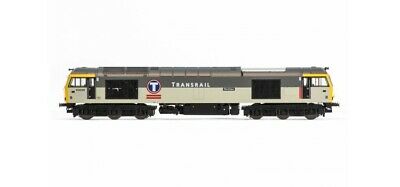-40%
Hornby R3267XS, Transrail Co-Co Diesel Electric Class 60 with DCC Sound
$ 111.04
- Description
- Size Guide
Description
R3267XS,Transrail Co-Co Diesel Electric Class 60 with DCC Sound
Digital control (DCC) has many advantages over the conventional DC control. One of the most the most dramatic bonuses of operating DCC must our superb locomotives fitted with sound.
A layout becomes wonderfully alive when sound can be heard from the locomotives. What can be more evocative than the sound of a locomotive pulling a full rake of coaches, running at full throttle with its whistle blowing as it rushes through a station?
The Class 60 was British Rail’s final attempt to produce an indigenous heavy hall freight locomotive. The Class 60 followed the introduction in 1986 of the American built Class 59 which had haulage capabilities way above existing BR locomotives. Their success made Railfreight’s Trainload sectors – Coal, Construction, Metals and Petroleum press BR for replacement of their ageing, ineffective and unreliable locomotive stock. Funding was authorised to develop a new Type 5 diesel designated Class 60 with the contract for 100 locomotives being awarded to Brush Traction on 17
th
May 1988.
The design specification took many features from the Class 59. Sepex anti wheel slip systems were also installed to improve adhesion. The locomotive bodies were built by Procor and equipped with power units by Mirrlees which delivered a maximum output of 3,1000HP and a speed of 60mph.
The first locomotive was handed over to Railfreight on time in June 1989 but extensive teething problems (many involving computer software) meant that it took 16 months before the first of the Class were accepted and nearly 4 years to introduce all 100 Class 60 locomotives.
By the time the Class 60 fleet entered service Trainload’s Sector businesses had given way to “shadow” privatisation and the formation in 1994 of Loadhaul, Transrail and Mainline Freight with the Class 60 fleet split equally between them. Five locomotives were repainted in Loadhaul’s distinctive black and orange livery, while 3 were finished in the aircraft blue colour scheme of Mainline Freight, however Transrail did not adopt a new livery.
English, Welsh and Scottish Railway bought the whole Class 60 fleet as part of BR’s privatisation and during 1996 began painting the locomotives into its new red and gold livery. Originally all 100 locomotives were allocated to Toton but today the Class can be seen all over the UK rail network on most freight workings.
Entering service as a Transrail locomotive in April 1991, 60005 “Skiddaw” was first liveried in the Trainload Construction colours. Currently 60005 carries the EWS red livery but without the “Skiddaw” nameplate. The locomotive is currently owned by DB Schenker, however the locomotive was transferred to Toton New Bank Sidings in November 2010 where it presently remains.











